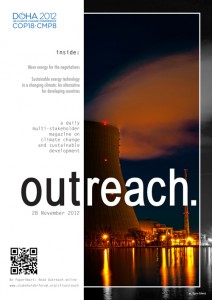Published in Outreach | COP-18, Doha | 28 November 2012 
Alexander Ochs, Director of Climate and Energy, Worldwatch Institute
More than half of all human-caused greenhouse gas emissions result from the burning of fossil fuels for energy supply. Even excluding traditional biomass, fossil fuel combustion accounts for 90 percent of carbon dioxide (CO2) emissions. Against this background, it is surprising how limited a role energy is playing in the ongoing climate negotiations. And yet this discussion could be instrumental in refocusing the debate about what is necessary and what is possible in both the areas of climate mitigation and adaptation—bringing it back down from the current inscrutable spheres of negotiation tracks, subsidiary bodies, parallel sessions, ad-hoc working groups, and special meetings (which, let’s be frank, nobody outside the negotiators understands anymore).
First, a focus on energy shows how far we are from solving the climate crisis. Energy-related CO2 emissions grew 3.2 percent in 2011 to more than 31 gigatons—despite the economic crisis. We know that if we don’t want to lose track of the 2-degree Celsius threshold of maximum warming that would hopefully avoid major disasters, energy emissions must decline by at least one third to 20 gigatons in 2035, despite expectations that energy demand might double in the same time frame. .
So the challenge is enormous. But—and this is where the good news starts—clean energy solutions are at hand, ready to be implemented. The costs for wind, solar, sustainable hydro, biomass and waste energy technologies all continue to fall rapidly, and, in many markets, they are becoming price competitive with fossil fuels—even if externalities and fossil fuel subsidies are not internalized. If they are, the cost that our societies pay for our continued reliance on fossil fuels becomes truly outrageous: Coal, responsible for 71 percent of global energy-related CO2 emissions, causes more than US$100 billion in local pollution and health care costs annually in the United States alone, in addition to the personal hardships of those suffering from these impacts. Add the costs for climate change, and it becomes incomprehensible why our societies continue down the fossil path despite the availability of alternatives.






